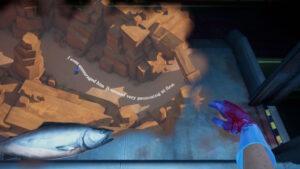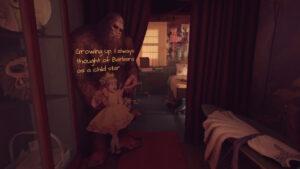For this critical play, I played “What Remains of Edith Finch”. The game was released in 2017 for PlayStation 4, Windows, and Xbox One, and is now also available on Nintendo Switch and iOS. Its ESRB rating is T for Teen, and it was developed by Giant Sparrow and published by Annapurna Interactive. The story follows Edith Finch as she explores her old family home in an attempt to discover more about her past and the mystery surrounding her family curse, where most members of her family have met bizarre and untimely deaths. In the game, walking tells the story by allowing users to experience both a third-person narration of each family member’s story, and simultaneously a first-person perspective of the narrative as it’s being described.
While playing as Edith Finch, the player explores the rooms of deceased family members and starts to uncover the story of their deaths. The game employs a third-person perspective as you walk around and interact with memorabilia from your deceased family members around the abandoned house. But you can interact with objects that then immerse you in the first-person perspective of a family member during the supposed story of their death. Allowing players to experience each character’s story through both Edith and the family members’ perspectives allows players to empathize with each character in a more immersive way. For example, in Lewis’ story, we play as Lewis as he daydreams while working in the fish cannery. The right controller has to constantly be chopping fish with the guillotine while the left controller navigates through Lewis’ daydream. The daydream continues to get bigger until the fish are barely visible; as players, we get to experience Lewis’ escape into his fantasies and how they distance him from reality. Forcing players to multitask in this way enhances the level of player immersion in the narrative. Another example of switching perspectives in the game that I enjoyed was the story about Barbara. The player simultaneously reads a comic book about her death while also acting out the scenes in the pages. In this case, players weave between both a first-person and third-person perspective, further enhancing their engagement with the situations happening in the story.


In addition, having the third-person perspective from Edith as she explores the area allows us to see the lived experiences and history that permeate different areas of the family home. We see Edith’s thoughts appear on walls and objects, attaching meaning and significance to these different things in the home. This allowed me to experience the story as if I was traversing through memories, adding a feeling of nostalgia to the storytelling. Building in a third-person perspective gave me a the sense that I was looking into the past and walking through history. If the game had only stuck to a first-person perspective, I think that this aspect of the story would have been lost. But experiencing both a third-person and first-person perspective throughout the game both enhanced the tragic nature of the story while also allowing me to empathize with the individual stories of different characters.




